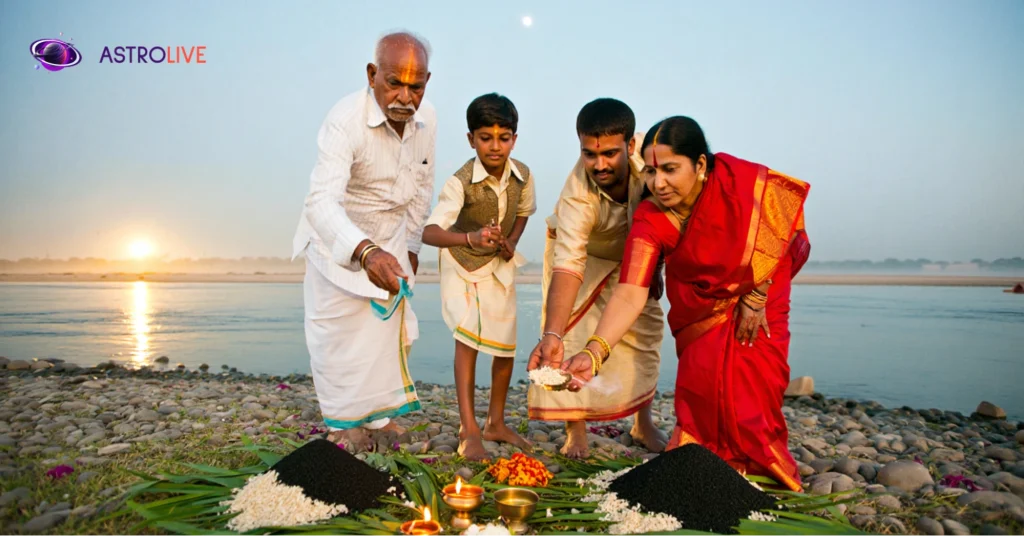Mahalaya Amavasya 2025 is one of the most blessed days in the Hindu calendar, dedicated to paying homage to our ancestors and seeking their blessings.
It marks the conclusion of Pitru Paksha, the fortnight devoted to ancestral rites, and paves the way for the beginning of Devi Paksha, which culminates in Durga Puja and Navratri celebrations.
On this day, devotees perform tarpan, shraddha, and pind daan with deep devotion, believing that these rituals bring peace to the departed souls and prosperity to their families.
Knowing the date, timings, rituals, and significance of Mahalaya 2025 can help you observe this auspicious occasion with greater faith and understanding.
What Is Mahalaya Amavasya?

Mahalaya Amavasya, also known as Pitru Amavasya or Sarvapitri Amavasya, is a highly religious day in Hindu tradition because it is dedicated to honouring one’s ancestors.
It falls on the new moon day (Amavasya) in the month of Bhadrapada or Ashwin (September–October), and is considered the concluding day of Pitru Paksha, the fortnight devoted to performing rites for departed souls.
On this day, Hindus perform tarpan (water oblations) and shraddha (ancestral offerings) with faith and devotion.
These rituals are believed to bring peace to the departed souls and ensure their blessings for the well-being, prosperity, and protection of the family. It is said that performing these acts of reverence helps the souls attain liberation, known as Pitru Moksha.
Several mythological stories highlight the importance of Mahalaya Amavasya. One of the most popular is the tale of Karna from the Mahabharata, who, after his death, was offered only gold and jewels in the afterlife because he had donated wealth but not food during his lifetime.
Distressed, Karna prayed to Yama, the god of death, and was granted permission to return to earth during Pitru Paksha to offer food to the needy and perform rituals for his ancestors. This legend underlines the importance of food offerings on Mahalaya Amavasya.
In Bengal, Mahalaya also holds special significance as it marks the descent of Goddess Durga to Earth. The day is observed with the recitation of Mahishasura Mardini and the beginning of Devi Paksha, which leads into the grand Durga Puja festivities.
Thus, knowing the Mahalaya Amavasya date is important, as this day is not just a time of remembrance but also a sacred bridge between generations, linking the living with their departed forefathers through rituals, devotion, and blessings.
Explore More
Saraswati Yoga In Vedic Astrology: Meaning & Significance
What 606 Angel Number Says About Life & Spiritual Growth?
When Is Mahalaya Amavasya 2025? Date, Tithi & Timings
Many devotees frequently ask, “When is Mahalaya Amavasya 2025?” According to the Hindu Panchang, Mahalaya Amavasya 2025 will be observed on Sunday, 21st September 2025. This day marks the conclusion of Pitru Paksha and is considered the most auspicious time to perform tarpan and shraddha for one’s ancestors.
Amavasya Tithi (Lunar Day) Timings:
- Amavasya Tithi Begins: 06:20 AM, 21st September 2025
- Amavasya Tithi Ends: 03:45 AM, 22nd September 2025
(Timings may vary slightly depending on location and regional Panchang.)
Auspicious Muhurat for Rituals:
- Morning Rituals (Tarpan & Shraddha): Sunrise till midday is considered highly sacred.
- Afternoon Rituals: Shraddha ceremonies and food offerings are best performed during Kutup Muhurat (around midday).
Regional Variations:
In most parts of India, Mahalaya Amavasya is observed on 21st September 2025.
However, in the Telugu calendar tradition, some households may observe it earlier, on 8th September 2025, as per local customs. Despite these variations, the spiritual essence remains the same, honouring ancestors with devotion and gratitude.
Check Your Daily Horoscope For Personalized Guidance Today
Mahalaya Amavasya & Pitru Paksha 2025
Mahalaya Amavasya is closely connected with Pitru Paksha, dedicated to performing rituals for departed ancestors. Pitru Paksha begins on the Purnima (Full Moon) of the month of Bhadrapada and ends on the Amavasya (New Moon) day, which is observed as Mahalaya Amavasya.
Pitru Paksha 2025 Dates
- Pitru Paksha Begins: Monday, 8th September 2025
- Pitru Paksha Ends (Mahalaya Amavasya / Sarvapitri Amavasya): Sunday, 21st September 2025
During these sixteen days, people perform shraddha, tarpan, and pind daan for their forefathers. Each day is dedicated to specific ancestors based on their tithi (lunar day of death).
Importance of Mahalaya Amavasya (Sarvapitri Amavasya)
The last day of Pitru Paksha, known as Mahalaya Amavasya or Sarvapitri Amavasya, is the most significant of all. On this day, those who are unable to perform shraddha on the exact death anniversary of their ancestors can do it collectively. It is believed that performing rituals on Mahalaya Amavasya provides peace to all departed souls and ensures their blessings for the family’s well-being and prosperity.
Thus, Mahalaya Amavasya 2025 not only marks the conclusion of Pitru Paksha but also highlights the significance of Mahalaya Amavasya Pitru Paksha, serving as the ultimate opportunity for devotees to express gratitude and seek the blessings of their ancestors.
Rituals of Mahalaya Amavasya 2025

On Mahalaya Amavasya 2025, the main practices include tarpan, shraddha, and pind daan, performed with faith and sincerity. Below is a step-by-step guide:
1. Early Morning Bath and Preparation
- Wake up before sunrise and take a holy bath in a river, pond, or at home.
- Wear clean, preferably white or traditional clothes.
- Arrange the required items for the rituals, such as sesame seeds, rice, darbha grass, water, black til, fruits, and cooked food.
2. Performing Tarpan
- Face south, the direction of ancestors, while performing the ritual.
- Offer water mixed with sesame seeds and darbha grass while chanting mantras.
- This is done to quench the thirst of the departed souls and bring them peace.
3. Shraddha Ceremony
- Prepare simple satvik food such as kheer, puri, dal, and seasonal vegetables.
- Offer food first to Brahmins or priests and seek their blessings.
- Some families also feed cows, dogs, and crows, as it is believed that ancestors accept food in these forms.
4. Pind Daan
- Prepare pindas (rice balls mixed with til and ghee) and offer them to the ancestors.
- This ritual symbolises nourishment and liberation for departed souls.
5. Charity and Feeding the Needy
- Donate clothes, grains, food, and money to the poor and needy.
- Offering help in the name of ancestors is considered highly meritorious.
6. Lighting a Diya
- In the evening, light a diya (lamp) near the Tulsi plant or at the sacred space at home.
- This is believed to guide the ancestors’ souls towards peace and moksha.
By performing these Mahalaya Amavasya 2025 rituals with devotion, devotees can also take advantage of Mahalaya Amavasya 2025 Puja services, believing that their ancestors will bless them with good health, prosperity, and protection from obstacles.

Regional Traditions & Cultural Practices of Mahalaya Amavasya 2025
While the essence of Mahalaya Amavasya 2025 remains the same across India, honouring ancestors with tarpan and shraddha, the way it is observed varies from region to region, reflecting the richness of Indian traditions.
West Bengal
In Bengal, Mahalaya marks the beginning of Devi Paksha and the countdown to Durga Puja. The day starts with the enchanting radio broadcast of Mahishasura Mardini, a devotional programme narrating Goddess Durga’s victory over Mahishasura.
Families perform tarpan at the banks of the Ganga and prepare for the arrival of Maa Durga, while idol makers complete Durga idols with Chokkhu Daan, painting the eyes to symbolise divine presence. Homes are cleaned and decorated, temples hold special prayers and Chandi Path recitations, and communities celebrate with music, dance, and cultural programs.
South India (Tamil Nadu, Karnataka, Andhra Pradesh, Telangana)
In South India, Mahalaya Amavasya is observed with temple rituals and ancestral offerings. Devotees visit sacred rivers and temples to perform tarpan and pind daan. In Telangana, the period also coincides with preparations for Bathukamma, the floral festival dedicated to Goddess Gauri, symbolising the transition from Pitru Paksha to Devi worship.
Odisha, Maharashtra, and Uttar Pradesh
In states like Odisha and Maharashtra, families observe shraddha at home or near water bodies. Offering pindas and food to priests, crows, and cows is considered essential. In Uttar Pradesh, especially along the banks of the Ganga in Varanasi, Gaya, and Prayagraj, devotees gather in large numbers to perform ancestral rites, believing these holy sites grant greater spiritual merit.
Astrological & Spiritual Importance Of Mahalaya Amavasya 2025
Apart from its cultural and ritual significance, Mahalaya Amavasya 2025 holds immense astrological and spiritual value.
This day falls on Amavasya (new moon), when the Sun and Moon are in conjunction, creating a powerful cosmic alignment. It is believed that performing ancestral rites during this period helps in removing Pitru Dosha, brings peace to departed souls, and ensures prosperity, health, and harmony for the family.
Astrological Significance:
- Pitru Dosha Remedies: Performing shraddha, tarpan, and charity helps reduce the negative effects of Pitru Dosha in a person’s horoscope.
- Influence on Zodiac Signs: The Amavasya energy is considered beneficial for all zodiac signs, particularly for those seeking blessings for longevity, family welfare, and financial stability.
- Spiritual Benefits: Devotees believe that sincere rituals performed on this day can free ancestors from karmic burdens and bring mental peace and spiritual upliftment to the living.
If you want to know more about how Mahalaya Amavasya 2025 affects your zodiac or specific remedies for Pitru Dosha, you can connect with an expert astrologer who can guide you on personalized rituals and puja timings.
Conclusion
Mahalaya Amavasya 2025 is more than just a date on the calendar; it is a sacred opportunity to honour our ancestors, seek their blessings, and connect with our spiritual roots. Observing the rituals of tarpan, shraddha, and pind daan with devotion brings peace to departed souls and ensures prosperity, health, and harmony for the family.
From regional traditions in Bengal and South India to modern practices for urban devotees, this day beautifully blends cultural heritage with spiritual significance. By understanding the date, timings, rituals, and astrological importance, you can make the most of this auspicious occasion.
Whether you perform the rituals at home, visit temples, or consult an expert astrologer for personalised guidance, the essence remains the same: gratitude, devotion, and reverence for those who came before us.
Celebrate Mahalaya Amavasya 2025 with faith by opting for the Mahalaya Amavasya 2025 Puja service by AstroLive, and let this sacred day strengthen the bond between the living and their ancestors.

FAQs About Mahalaya Amavasya 2025
1. Can Mahalaya Amavasya rituals be performed for distant ancestors?
Yes. Even if you do not know the exact names or details of distant forefathers, performing tarpan and shraddha in a general sense is believed to bring peace and blessings to all ancestors.
2. Is it necessary to go to a river or temple for the rituals?
No. While performing rituals at holy rivers or temples is considered auspicious, you can conduct Mahalaya Amavasya puja at home using clean water, symbolic offerings, and mantras.
3. Can women perform Mahalaya Amavasya rituals?
Absolutely. Both men and women can perform these rituals. In many households, women actively participate in preparing offerings, lighting lamps, and reciting mantras.
4. Can Mahalaya Amavasya be observed virtually or online?
Yes. Several temples and spiritual organizations offer online puja services, allowing devotees to sponsor rituals or participate virtually, especially helpful for people living abroad.







